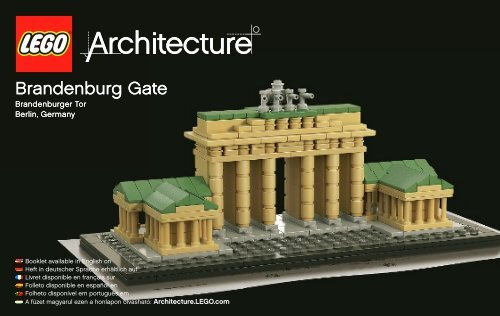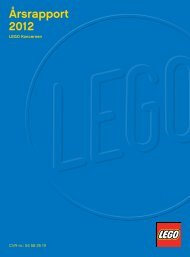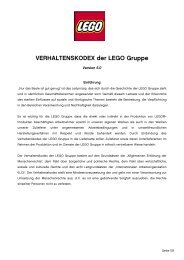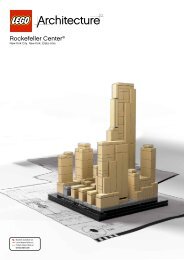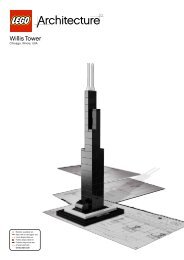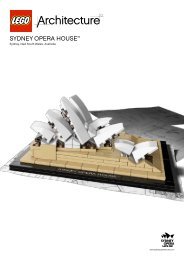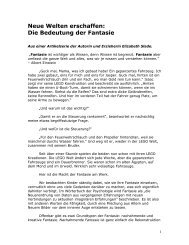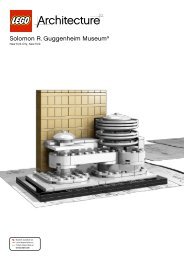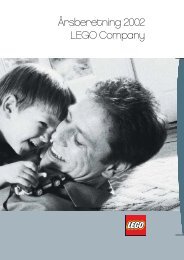Brandenburg Gate Brandenburg Gate
Brandenburg Gate Brandenburg Gate
Brandenburg Gate Brandenburg Gate
Create successful ePaper yourself
Turn your PDF publications into a flip-book with our unique Google optimized e-Paper software.
<strong>Brandenburg</strong> <strong>Gate</strong><br />
<strong>Brandenburg</strong>er Tor<br />
Berlin, Germany<br />
Booklet available in English on<br />
Heft in deutscher Sprache erhältlich auf<br />
Livret disponible en français sur<br />
Folleto disponible en español en<br />
Folheto disponível em português em<br />
A füzet magyarul ezen a honlapon olvasható: Architecture.LEGO.com
2<br />
The <strong>Brandenburg</strong> <strong>Gate</strong><br />
The <strong>Brandenburg</strong> <strong>Gate</strong> (in German: <strong>Brandenburg</strong>er<br />
Tor) is one of Berlin’s most important monuments–an<br />
architectural landmark and historical symbol all in one.<br />
It has been at the heart of German and European history<br />
for over two hundred years.<br />
Commissioned by King Frederick William II of<br />
Prussia as a sign of peace, it was built as the grandest of<br />
a series of 18 city gates through which Berlin was once<br />
entered. The entire construction and ornamentation of<br />
the <strong>Gate</strong> reflected its extraordinary importance as the
monumental entry to Unter den Linden, the renowned<br />
boulevard of linden trees, which formerly led directly to the<br />
city palace of the Prussian monarchs.<br />
The <strong>Gate</strong> was constructed between 1788 and 1791<br />
according to the designs of its architect, Carl Gotthard<br />
Langhans. His inspiration for the building came from the<br />
Propylaea in Athens, the monumental entry hall of the<br />
Acropolis. Just as the Propylaea led to a shrine of the<br />
ancient world, the <strong>Brandenburg</strong> <strong>Gate</strong> was to represent the<br />
access to the most important city of the Prussian kingdom.<br />
Propylaea, entry hall of the Acropolis The <strong>Gate</strong> is built in sandstone Twelve columns, six to each side<br />
With its direct reference to antiquity, the gate founded the<br />
Classic age of architecture in Berlin, an epoch that soon<br />
led the city to be called “Athens of the Spree” (in German:<br />
Spreeathen), after the river that runs through it.<br />
The <strong>Gate</strong> itself is built in sandstone and consists<br />
of twelve Doric columns, six to each side, forming five<br />
passageways. Citizens originally were allowed to use only<br />
the outermost two, the central passageway being reserved<br />
for Prussian royalty and visiting foreign dignitaries.<br />
3
4<br />
Atop the gate is the Quadriga, a chariot drawn by<br />
four horses driven by Victoria, the Roman goddess of<br />
victory. It was created by Johann Gotfried Schadow,<br />
the most important sculptor in Berlin during this<br />
period. The relief on the pedestal portrays Victoria<br />
together with a number of attendants who personi-<br />
fied virtues such as friendship and statesmanship. Along<br />
with symbols of arts and sciences, these were seen<br />
as vital components ensuring the city would bloom
in times of peace. Down in the passageways, reliefs<br />
depicting the exploits of Hercules alluded to the time<br />
of the War and the subsequent period of reconstruction,<br />
during which time King Frederick William II had made<br />
Prussia into a true European power.<br />
Though the <strong>Brandenburg</strong> <strong>Gate</strong> has remained essentially<br />
unchanged since its completion, it has had a central role<br />
in many of Europe’s most monumental historical events.<br />
In 1806, Napoleon marched triumphantly into Berlin and<br />
Bundesarchiv, Bild 183-M10 15-327. Photo: Donath, Otto І April 1950<br />
Bundesarchiv, Bild 183-S89875. Photo: Quaschinsky, Hans-Gunter І November<br />
1949<br />
5
6<br />
carried the Quadriga away with him to Paris as a spoil of war.<br />
After Napoleon’s defeat in 1814 and the Prussian occupation<br />
of Paris, the Quadriga was restored to Berlin and Victoria’s<br />
wreath of oak leaves was supplemented with a new symbol<br />
of Prussian power, the Iron Cross. In 1933 the National Socialists<br />
marched through the gate in a martial torch parade,<br />
introducing the darkest chapter of German history, ultimately<br />
leaving the city in ruins and Germany divided.<br />
When Berlin was partitioned after World War II, the<br />
center of the city fell into the Soviet sector, which met the<br />
British sector at the <strong>Brandenburg</strong> <strong>Gate</strong>. After a series of<br />
demonstrations against the building of the Berlin Wall, the<br />
Soviets closed the <strong>Brandenburg</strong> <strong>Gate</strong> on August 14th, 1961.<br />
It remained closed until December 22nd, 1989, when the<br />
wall fell and East and West Berlin were unified once again.<br />
Throughout this turbulent period of history, the<br />
<strong>Brandenburg</strong> <strong>Gate</strong> had fallen into general disrepair. In 2000,<br />
the Berlin Monument Conservation Foundation (in German:<br />
Stiftung Denkmalschutz Berlin) began a full restoration of<br />
the <strong>Brandenburg</strong> <strong>Gate</strong>. It opened to the public again two
years and six million US dollars later on October 3rd, 2002,<br />
the twelfth anniversary of German Reunification.<br />
Today, the <strong>Brandenburg</strong> <strong>Gate</strong> is regarded as one of<br />
Europe’s most famous landmarks.<br />
Carl Gotthard Langhans (December 15, 1732–October 1,<br />
1808) was born in Landeshut, Silesia (now in Poland). He was<br />
not originally educated as an architect. Instead he studied<br />
law from 1753 to 1757 and then mathematics and languages.<br />
He taught himself architecture using the antique texts of the<br />
Roman architecture theorist Vitruvius.<br />
His first draft of “Zum Schifflein Christi” for the<br />
Protestant Church in 1764 in Groß-Glogau earned him both<br />
his first recognition as an architect and an appointment as<br />
building inspector for the Count of Hatzfeld, whose warravaged<br />
palace he had rebuilt to his own design between<br />
1766 and 1774. Through the intervention of the Count of<br />
Hatzfeld, Langhans also became known at the royal court<br />
in Berlin, and this would eventually lead to arguably his<br />
greatest work: the <strong>Brandenburg</strong> <strong>Gate</strong>. He died at Grüneiche<br />
near Breslau (now in Poland) in 1808.<br />
7
8<br />
Facts about <strong>Brandenburg</strong> <strong>Gate</strong><br />
Location: .................................... Berlin, Germany<br />
Architect:.................................... Carl Gotthard Langhans<br />
Architectural style: .............. Classicism<br />
Materials: ................................... Sandstone<br />
Date of construction: ......... From 1788 to 1791
1<br />
3x<br />
2x<br />
9
2<br />
10<br />
3x 3x
1x<br />
3<br />
1x<br />
2x<br />
11
4<br />
12
1x<br />
5<br />
1x<br />
1x<br />
At the base of <strong>Brandenburg</strong> <strong>Gate</strong><br />
lies Pariser Platz, a popular city<br />
square, which was once home<br />
to embassies, the houses of<br />
noblemen and grand hotels. At the<br />
end of World War II, the <strong>Gate</strong> was<br />
one of the few structures in the<br />
square left standing.<br />
13
6<br />
14<br />
2x
2x<br />
7<br />
6x<br />
15
4x<br />
8<br />
16<br />
6x<br />
3x
9<br />
4x 4x<br />
Shortly after the Thirty Years’<br />
War, and a century before<br />
the Branderburg <strong>Gate</strong> was<br />
constructed, Berlin was a small<br />
walled city within a star fort with<br />
several named gates: Spandauer<br />
Thor, St. Georgen Thor, Stralower<br />
Thor, Cöpenicker.<br />
17
10<br />
18<br />
6x
11<br />
6x<br />
19
12<br />
20<br />
4x
13<br />
2x<br />
21
14<br />
22<br />
4x
15<br />
4x<br />
23
16<br />
24<br />
4x
17<br />
4x<br />
On June 12, 1987, U.S.<br />
President Ronald Reagan<br />
spoke to West Berliners<br />
at the <strong>Brandenburg</strong> <strong>Gate</strong>,<br />
and called for his Soviet<br />
counterpart to “Come here<br />
to this gate! Mr. Gorbachev,<br />
open this gate!”<br />
25
2x 2x 2x<br />
18<br />
26
19<br />
24x<br />
27
20<br />
28<br />
20x
21<br />
20x<br />
29
22<br />
30<br />
16x
23<br />
12x<br />
6x<br />
31
24<br />
32<br />
48x<br />
12x
25<br />
4x<br />
The 12 Doric columns, six on<br />
each side of the <strong>Gate</strong>, support<br />
the gate’s 11 meters (36foot)<br />
long transverse beam.<br />
33
1x 2x<br />
26<br />
34
27<br />
2x 8x<br />
A complete refurbishment<br />
of the <strong>Gate</strong> was carried out<br />
in 2000, and took two years<br />
to complete at a cost of six<br />
million US dollars.<br />
35
8x 4x<br />
1x<br />
28<br />
36
29<br />
24x<br />
12x<br />
37
30<br />
38<br />
1x 2x
31<br />
4x<br />
In the 1980s, decrying the<br />
existence of two German<br />
states, West Berlin mayor<br />
Richard von Weizäcker<br />
said: “The German question<br />
is open as long as the<br />
<strong>Brandenburg</strong> <strong>Gate</strong> is<br />
closed.”<br />
39
32<br />
40<br />
12x
33<br />
2x<br />
41
1x 2x 8x 4x<br />
34<br />
1 2 3<br />
42
4x<br />
1x 2x<br />
35<br />
1x<br />
1 2<br />
3<br />
44
One of the most famous<br />
speeches given in front of<br />
the <strong>Brandenburg</strong> <strong>Gate</strong> was<br />
that of US President John F.<br />
Kennedy in 1963, where he<br />
said the famous words “Ich<br />
bin ein Berliner”.<br />
45
36<br />
46<br />
4x
37<br />
2x 1x 3x<br />
47
38<br />
48<br />
10x
39<br />
1x 3x<br />
1 2<br />
49
40<br />
50<br />
4x
12x<br />
4159279<br />
4x<br />
4114319<br />
2x<br />
4181134<br />
48x<br />
4117070<br />
9x<br />
4125253<br />
10x<br />
4159553<br />
8x<br />
4114026<br />
2x<br />
4113917<br />
2x<br />
4121921<br />
4x<br />
4118790<br />
1x<br />
4113233<br />
4x<br />
4550324<br />
4x<br />
4114309<br />
10x<br />
4113993<br />
4181134<br />
2x<br />
4114324<br />
8x<br />
4155708<br />
13x<br />
4565387<br />
32x<br />
4161734<br />
12x<br />
4653657<br />
6x<br />
306926<br />
1x<br />
4653640<br />
1x<br />
379526<br />
7x<br />
416226<br />
8x<br />
244526<br />
80x<br />
4652205<br />
13x<br />
4616578<br />
1x<br />
4211511<br />
7x<br />
4211413<br />
8x<br />
4211445<br />
4x<br />
4211356<br />
10x<br />
4211395<br />
6x<br />
4211438<br />
6x<br />
4211549<br />
1x<br />
4611702<br />
5x<br />
4211525<br />
4x<br />
4211503<br />
2x<br />
4211094<br />
4211094<br />
2x<br />
4211122<br />
3x<br />
4211114<br />
51
52<br />
A Word from the Artist<br />
As an Architectural Artist my desire is to capture the essence<br />
of a particular architectural landmark into its pure sculptural<br />
form. I fi rst and foremost do not view my models as literal<br />
replicas, but rather my own artistic interpretations through<br />
the use of LEGO ® bricks as a medium. The LEGO brick is<br />
not initially thought of as a material typically used in creating<br />
art or used as an artist’s medium. I quickly discovered the<br />
LEGO brick was lending itself as naturally to my applications<br />
as paint to a painter or metal to a blacksmith. As I explore<br />
how to capture these buildings with the basic shapes of the<br />
bricks and plates, I fi nd the possibilities and challenges they<br />
off er almost magical.<br />
21011 <strong>Brandenburg</strong> <strong>Gate</strong><br />
Following the parameters found among the landmark series<br />
it was important to maintain a souvenir scaled model. This<br />
historical monument contains architectural styling and motifs<br />
diffi cult to accurately replicate at a smaller size. For instance,<br />
the colonnades are made using railings scaled to be roughly<br />
3 feet high, but here clearly take on the feel of 20 foot tall<br />
columns.<br />
Another interesting detail attributed to achieving a<br />
small scale is how to eff ectively represent the monument’s<br />
sculpture of the Quadriga, a four-horsed chariot driven by<br />
Victoria, the winged goddess of victory, found crowning the<br />
top of the gate. This very distinctive feature was recreated<br />
using “greebles”–the use of unintended parts to recreate<br />
another object in an abstract way.<br />
While this model is seemingly a straightforward build,<br />
achieving the ½ stud width cantilever found highlighting the<br />
parameter where the upper cornice meets the frieze seemed<br />
tricky. The technique used turned out to be a simple solution<br />
using 1x1 round plates off set between 4 full studs and 2x2<br />
tiles above completing the proportionally correct ½ stud<br />
overhang.<br />
– Adam Reed Tucker
The “Scale Model” line – LEGO ® Architecture in the 1960s<br />
The history of current LEGO ® Architecture series<br />
can be traced back to the beginning of the 1960s when<br />
the LEGO brick’s popularity was still steadily increasing.<br />
Godtfred Kirk Christiansen, the then owner of the<br />
company, began looking for ways to further expand the<br />
LEGO system, and asked his designers to come up with a<br />
set of new components that would add a new dimension<br />
to LEGO building.<br />
Their answer was as simple as it was revolutionary:<br />
five elements that matched the existing bricks, but were<br />
only one third the height. These new building “plates”<br />
made it possible to construct more detailed models than<br />
before.<br />
This greater LEGO flexibility seemed to match<br />
the spirit of the age; where modernist architects were<br />
redefining how houses looked, and people were taking<br />
an active interest in the design of their dream home. It<br />
was from these trends that the LEGO “Scale Model” line<br />
was born in early 1962.<br />
The name itself was a direct link to the way<br />
architects and engineers worked, and it was hoped that<br />
they and others would build their projects “to scale” in<br />
LEGO elements. As with LEGO Architecture today, the<br />
original sets were designed to be different from the<br />
normal brightly colored LEGO boxes, and also included<br />
An Architectural Book for inspiration.<br />
Though the five elements remain an integral part of<br />
the LEGO building<br />
system today, the<br />
“Scale Model” was<br />
phased out in 1965<br />
–it would be over<br />
40 years before its<br />
principles would<br />
be revived in the<br />
LEGO Architecture<br />
series we know<br />
today.<br />
53
54<br />
Architecture series
Landmark series<br />
References<br />
Photo credits:<br />
Bundesarchiv<br />
Bundesregierung<br />
Customer Service<br />
Kundenservice<br />
Service Consommateurs<br />
Servicio Al Consumidor<br />
www.lego.com/service or dial<br />
00800 5346 5555 :<br />
1-800-422-5346 :<br />
55
LEGO and the LEGO logo are trademarks of the LEGO Group. ©2011 The LEGO Group. 6005322


